Crypto Value Converter
When governments cut off access to banks, payment systems, and foreign currency, people don’t stop trading. They find another way. In countries under international sanctions-like Iran, North Korea, and Russia-citizens have turned to cryptocurrency not as a luxury, but as a lifeline. It’s not about speculation. It’s about survival. Buying medicine. Sending money to family. Paying for education. Getting paid for work done online. Crypto doesn’t ask for a passport. It doesn’t care which flag you fly. And that’s why it’s become the most reliable financial tool for millions trapped behind digital walls.
How They Get In When Exchanges Are Blocked
Most major exchanges-Coinbase, Binance, Kraken-have compliance teams that block users from sanctioned countries. But that doesn’t stop people. They don’t need to sign up on those platforms directly. Instead, they use intermediaries: peer-to-peer (P2P) marketplaces, decentralized exchanges (DEXs), and Telegram-based bots that operate outside traditional oversight. In Iran, users often trade through local platforms like Nobitex or Digifin. But when Tether froze 42 Iranian-linked wallet addresses in July 2025, users didn’t panic. They moved. Fast. Within days, thousands switched from USDT to DAI, a stablecoin built on the Polygon network. Why? Because DAI is decentralized. It’s not controlled by a single company. And Polygon’s infrastructure is harder to shut down than centralized payment rails. In Russia, after Garantex was shut down in March 2025-with over $26 million seized by German and Finnish authorities-the entire user base migrated to Grinex. The new platform looked almost identical. Same interface. Same customer support. Same wallet addresses. Only the name changed. This isn’t rare. It’s standard. When one exchange gets hit, another pops up in its place, often hosted on servers in Dubai, Turkey, or Southeast Asia.The Tools They Use
Bitcoin remains the most popular asset for sanctioned users, making up 65% of all crypto transactions linked to these regions. Why? Because it’s the most liquid, the most recognizable, and the hardest to trace back to an individual if used correctly. Ethereum comes second at 18%, mostly used for smart contracts and stablecoin swaps. But the real game-changer has been stablecoins. DAI, USDC, and BUSD are the hidden workhorses. They let people store value without volatility. But USDC and USDT are centralized. Tether and Circle can freeze wallets. DAI can’t. It’s governed by code, not CEOs. So when sanctions hit, users switch to DAI like flipping a switch. They use decentralized bridges like Across or Synapse to move funds across chains without touching a regulated exchange. Mixers and privacy tools are also common. Tornado Cash-style services saw five major enforcement actions in 2024, but they’re still used. Not because users want to hide crime-they want to hide from surveillance. In Iran, people don’t want the government knowing they bought food online. In Russia, they don’t want their salary flagged as “suspicious.” Mixers help blur the trail.
How Exchanges Get Around the Rules
Some exchanges never intended to serve sanctioned countries. They just didn’t check. ShapeShift, a Swiss-based platform, paid $750,000 to OFAC in 2025 for letting users from Cuba, Iran, Sudan, and Syria trade on its site. Why? No KYC. No IP blocking. No compliance team. That’s still common among smaller platforms, especially those operating out of jurisdictions with weak oversight. Then there are the ones that knowingly skirt the rules. Exved, a payment processor based in Turkey, helps Russian businesses import dual-use goods-things like microchips and medical equipment-by routing crypto payments through shell companies. MKAN Coin, a Telegram-based exchange run from Dubai, mirrors Garantex’s entire business model. It doesn’t have a website. It doesn’t need one. It has a Telegram group with 80,000 members. Users send crypto. They get cash in local currency via local agents. No bank involved.Why Enforcement Keeps Failing
The U.S. Treasury’s Office of Foreign Assets Control (OFAC) has sanctioned 57 individuals and entities for crypto-related violations as of 2025. That’s up from just 3 in 2018. They’ve added over 1,200 crypto wallet addresses to their Specially Designated Nationals (SDN) list. They froze $150 million in a DeFi protocol in January 2025-the first time they ever targeted a smart contract. They’re spending more, acting faster, and working with INTERPOL and Europol. But they’re fighting a moving target. Every time a platform gets blocked, users shift to a new one. Every time a stablecoin is frozen, they switch to another. Every time a mixer is shut down, a new one appears with better obfuscation. The total value of illicit crypto transactions tied to sanctioned entities over the past two years? $6.9 billion. That’s not a drop in the bucket. It’s a flood. Even when enforcement works, it’s not always effective. Iran’s crypto inflows dropped 11% in early 2025 after Tether’s freeze. But activity didn’t stop. It just got quieter. More decentralized. More creative. The Iranian government even passed a new law in August 2025 taxing crypto profits-treating it like gold or forex. That’s not repression. That’s recognition. They know crypto isn’t going away.






dhirendra pratap singh
This is why the West is doomed 😭😭😭 They think they can control money? HA! People will always find a way. Even if you block every exchange, every wallet, every bridge - someone in a basement in Tehran will still send DAI to their sick mom. You can’t sanction human need. #CryptoIsFreedom